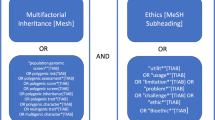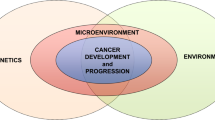Abstract
Drawing on empirical ethnographic research in Brazil this paper examines how in the spaces between identifying genetic markers and conditional cancer risk, environments and diverse epigenetic logics are emerging and being negotiated among research and clinical communities, patients and their families. Focusing on an arena of research and medical intervention related to a gene variant known as R337h, thought to occur with high frequency in the south of Brazil and linked to the cancer syndrome Li–Fraumeni, it emphasises the relevance of examining epigenetics as an emic category but also its utility as an analytic category. It shows how, in a context of not yet fully knowing how and in what ways R337h contributes to increased cancer, a range of different ‘environments’ are invoked that unevenly articulate an emerging and still inchoate and unfolding terrain of understanding. In an arena of expanding genomic research and medicine, where the identification of low-risk mutations associated with cancer is increasingly common, the Brazilian case provides a particular lens on the way environments and genes are being meaningfully calibrated and how differently implicated communities resourcefully populate the gaps in knowledge and understanding with consequences for research, care and embodied risk.
Similar content being viewed by others
Notes
This initial hypothesis does not seem to have gained much research traction across a broad cancer genetic research community in Brazil or elsewhere (see Armstrong, 2014). How it may be re-emerging or transformed by evolving terrains of epigenetic inquiry related to R337h requires further research.
It is possible that these would now be framed in much more explicit epigenetic frames of reference given this research terrain has likely evolved since my field work in 2010–2012.
This expression is not translated but were her exact words she used in English. She may have been referring to ‘cultural fingerprint’.
Later, this cancer specialist suggested that the high rate of breast cancer could be related to something in the environment in the region referring to water pollution. She did not however elaborate. While a focus on genetic ancestry facilitated discussion of cultural ‘behaviours’ it did not seem to easily widen a paradigm for research that included questions of pollution.
There were also some scientists who articulated similar doubts. One molecular biologist from Porto Alegre for instance said “perhaps we will never know absolutely know what is happening…there isn’t a 100% rule. There are so many factors that could be involved”. He also added however “the more we study the more doubts we have but we have to move forward with this.”
The term ‘Gaúcho’ refers to the regionally identified people of the southern most state of Rio Grande do Sul.
In other papers, I have also discussed how this history of social medicine also shapes the ‘activism’ of health professionals and their commitment to public health (see for instance Gibbon, 2016). See also Behague (2016) for a discussion of how the long duree of Brazilian public health has shaped the medicalisation of mental health in Brazil.
References
Achatz, M.I and Zambetti, G. (2017) The inherited P53 mutation in the Brazilian population. Cold Spring Harbor Perspectives in Medicine. https://doi.org/10.1101/cshperspect.a026195.
Achatz, M., et al. (2009) ‘Highly prevalent TP53 mutation pre-disposing to many cancers in the Brazilian Population: A case for new born screening?’The Lancet 10: 920–925.
Aureliano, W. (2014) Suffering in the Soul. Feeling in the Body. Contemporary interfaces between emotions, spirituality and health. Revista Brasileira de Sociologia da Emoção 13(37): 59–79.
Armstrong, S. (2014) P53. The Gene that Cracked the Cancer Code. London, Oxford: Bloomsbury Publishing.
Behague, D. (2016) Psychiatry, bio-epistemes and the making of adolescence in southern Brazil. História, Ciências, Saúde Manguinhos 23(1): 131–153.
Biehl, J. (2001) Vita: Life in a zone of social abandonment. Social Text 19(3): 131–149.
Custodio G., et al. (2013) Impact of neonatal screening and surveillance for the TP53 R337H mutation on early detection of childhood adrenocortical tumors. Journal of Clinical Oncology 31: 2619–2626.
Darling, K.W, Ackerman, S. Hiatt, R. Soo Jin Lee, S. and Shim, J. (2016) Enacting the molecular imperative. How gene-environment research links bodies and environments in the post-genomic age. Social Science and Medicine 155: 51–60.
Duarte, L.-F. (1986) Da vida nervosa nas classes trabalhadoras urbanas. Rio de Janeiro: Zahar.
Dupré, J. (2012) Processes of life: Essays in the philosophy of biology. Oxford, UK: Oxford University Press.
Edmonds, A. and Sanabria, E. (2014) Medical borderlands: Engineering the body with plastic surgery and hormonal therapies in Brazil. Anthropology and Medicine 21(2): 202–216.
Fortes et al (2015) DNA Methylation patterns of candidate genes regulated by thymine DNA glycosylase in patients with TP53 germline mutations. Brazilian Journal of Medical and Biological Research 48(7): 610–615.
Fox-Keller, E. (2010) The Mirage of a Space Between Nature and Nurture. Durham NC. Duke Univeristy Press.
Giacomazzi, J., et al. (2014) Prevalence of the TP53 p. R337h mutation in breast cancer patients in Brazil. PLoS ONE 9(6): e99893.
Gibbon, S. (2016) Translating genomics: Cancer genetics, public health and the making of the (de)molecularised body in Cuba and Brazil. Historia, Ciencias, Saude Manguinhos 23(1): 95–113.
Gibbon, S. (2017) Entangled local biologies. Genetic risk, bodies and inequities in Brazilian Cancer Genetics. Anthropology and Medicine 24: 174–188.
Gibbon, S., Joseph, G., Mozersky, J., zur Nieden, A. and Palfner, S. (2014) Breast Cancer Gene Research and Medical Practices: Transnational Perspectives in the Time BRCA. London: Routledge.
Kamikhara, J., Huma, Q.R. and Garber, J. (2014) Germline TP53 mutations and the changing landscape of Li-Fraumeni syndrome. Human Mutation 35: 654–662.
Kuhn dos Santos, R., Resegue, R. and Fiorini Puccini, R. (2012) Childcare and children’s healthcare: historical factors and challenges. Revista Brasileira de Crescimento e desenvolvimento humano 22(2): 160–165.
Lamoreaux. J. (2016) What if the environment is a person? Lineages of epigenetic science in toxic China. Cultural Anthropology 31(2): 188–214.
Landecker, H. (2011) Food as exposure: nutritional epigenetics and the new metabolism. Biosocieties 6(2): 167–194.
Landecker, H. and Panofsky, A. (2013) From social structure to gene regulation and back: A critical introduction to environmental epigenetics for sociology. Annual Review of Sociology 39: 333–357.
Lappé, M. and Landecker, H. (2015) How the genome got a life span. New Genetics and Society 34(2): 152–176.
Lloyd, S. and Raikhel, E. (2018). Environmental epigenetics and suicide risk at a molecular scale. In: S. Gibbon, et al (eds.) Routledge Handbook of Genomics, Health and Society. London: Routledge.
Lock, M. and Niewohner J. (this edition) Situated Biologies.
Mansfield, R. (2012) Race and the new epigenetic biopolitics of environmental health. Biosocieties 7: 352–372.
Meloni, M. (2016) Political Biology. Science and Social Values in Human Heredity from Eugenics to Epigenetics. Palgrave Macmillan.
Meloni and Testa (2014) Scrutinizing the epigenetics revolution. BioSocieties 9(4): 431–456.
Malkin, D. (1993) P53 and the Li-Fraumeni syndrome. Cancer Genetics 66(2) 83–92.
Martin, E. (1997) Anthropology and the cultural study of science. Science, Technology and Human Values 23 (1): 24–44.
Pickersgill, M. (2016) Epistemic modesty, ostentiousness and the uncertainties of epigenetics; on the knowledge machinery of (social) sciences. The Sociological Review 64(1):186–202.
Rebhun, L. (1994) Swallowing frogs: anger and illness in northeast Brazil. Medical Anthropology Quarterly 8(4):360–382.
Richardson (2015) Maternal bodies in the postgenomic order: Gender and the explanatory landscape of epigenetics. In: S. Richardson and H. Stevens (eds.) Postgenomics: Perspectives on Biology After the Genome. Durham: Duke University Press.
Sanabria, E. (2016) Plastic Bodies. Sex Hormones and Menstrual Suppression in Brazil. Durhman: Duke University Press.
Sange, C., et al. (2014) Age at cancer onset in germline TP53 mutation carriers: association with polymorphisms in predicted G-quadruplex structures. Carcinogenesis 35(4): 807–815.
Scheper-Hughes, N. (1989) Death Without Weeping. The violence of everyday life in Brazil. Berkeley: University of California Press.
Shostak, S. and Moinester, M. (2015) Beyond geneticization: regimes of perceptibility and social determinants of health. In: Reimagining Biomedicalization, Pharmaceuticals, and Genetics. New York, NY: Routledge.
Stepan, N. (1996) The Hour of Eugenics: Race, Gender and Nation in Latin America. Ithaca, NY: Cornell University Press.
Acknowledgements
I would like thank all those who agreed to participate in the outlined research. I extend my sincere gratitude and thanks to the anonymous reviewers and editors of the special issue who generously provided feedback. I also acknowledge the support of the Wellcome Trust who provided financial support for the research discussed in the article.
Author information
Authors and Affiliations
Corresponding author
Rights and permissions
About this article
Cite this article
Gibbon, S. Calibrating cancer risk, uncertainty and environments: Genetics and their contexts in southern Brazil. BioSocieties 13, 761–779 (2018). https://doi.org/10.1057/s41292-017-0095-7
Published:
Issue Date:
DOI: https://doi.org/10.1057/s41292-017-0095-7




